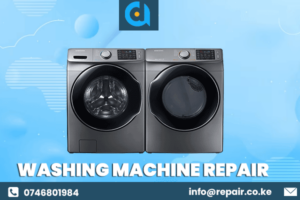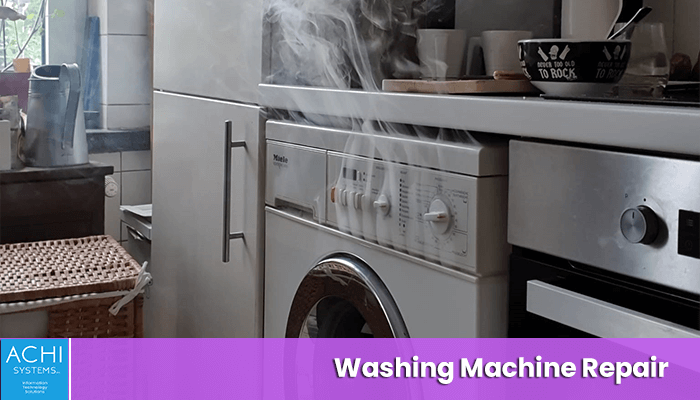Washing Machine Repair Services in Nairobi: A Comprehensive Guide by RepairKE
“Washing machine repair in Nairobi” as a service offered by Repair KE refers to the professional maintenance, troubleshooting, and resolution of issues or malfunctions in washing machines within the Nairobi area. This service is designed to ensure that washing machines, whether used in homes or businesses, function efficiently and effectively. Here is an overview of what Repair KE’s washing machine repair service in Nairobi may include:
- Diagnosis: Repair KE’s skilled technicians assess the washing machine to identify any problems or malfunctions. This involves inspecting various components such as the drum, motor, water inlet and outlet valves, pumps, and electrical systems.
- Troubleshooting: After identifying the issue, the technicians work to pinpoint the exact cause and determine whether any parts need to be repaired or replaced. Troubleshooting may include testing the machine’s cycle functions, checking for leaks, and evaluating electrical connections.
- Repairs: The technicians perform necessary repairs, which can include fixing or replacing faulty components, such as a malfunctioning motor, damaged belts, worn-out bearings, or a defective control panel. The goal is to restore the washing machine to proper working condition.
- Maintenance: In addition to addressing immediate issues, Repair KE may offer routine maintenance to prevent future problems. This can involve cleaning the drum and filters, checking for blockages in hoses, and ensuring that the machine’s moving parts are well-lubricated.
- Testing: After repairs and maintenance are completed, the technicians test the washing machine to verify that it functions correctly. This includes running a cycle, checking for consistent water temperature, and ensuring that the appliance operates efficiently.
- Safety Measures: Repair KE’s technicians adhere to safety guidelines and protocols, particularly when dealing with electrical components and potentially hazardous situations like water leaks.
- Replacement Parts: If replacement parts are required for the repair, Repair KE may source and install genuine or compatible components to ensure the washing machine’s reliability and longevity.
- Customer Education: Repair KE may also offer guidance to customers on how to use and maintain their washing machines properly. This education can help prevent future issues and optimize energy efficiency.
By offering washing machine repair services in Nairobi, Repair KE helps individuals and businesses avoid the inconvenience and expense of purchasing a new machine. These services are essential for keeping laundry routines running smoothly and ensuring that washing machines operate efficiently and effectively for years to come.

washing-machine-repair-nairobi-kenya
In the bustling urban environment of Nairobi, the modern household heavily relies on appliances like washing machines to streamline daily chores. However, these convenient devices are not immune to malfunctions, which can be frustrating for homeowners. This is where RepairKE steps in, offering top-notch washing machine repair services to ensure your appliance is back in optimal working condition. In this article, we’ll delve into common washing machine faults and their repair solutions provided by RepairKE.
Introduction to RepairKE, the lead washing machine repair company in Nairobi
RepairKE is a leading appliance repair service provider in Nairobi, dedicated to resolving a wide array of household appliance issues. Their team of skilled technicians specializes in diagnosing and fixing washing machine problems efficiently, providing a cost-effective alternative to purchasing new appliances.
Common Washing Machine Faults and their washing machine Repair Solutions
- No Power or Won’t Start: If your washing machine fails to power on, the problem could stem from a faulty power cord, outlet, or even the machine’s internal power components. RepairKE’s technicians first assess the power source and then diagnose whether the issue lies within the machine’s control board or wiring. A damaged power cord is a straightforward replacement, while internal power component repairs might involve soldering or replacing circuitry components.
- Drainage Issues: A washing machine that doesn’t drain properly can lead to water accumulation and potential damage. Common causes include clogged drain hoses, blocked filters, or malfunctioning drain pumps. RepairKE’s experts unclog hoses, clean filters, and if necessary, replace drain pumps to restore proper drainage.
- Leaking Problems: Leaks can arise from worn-out door seals, damaged hoses, or faulty water inlet valves. RepairKE’s technicians identify the source of the leak, whether it’s from a seal, hose, or valve, and then perform necessary replacements or repairs.
- Excessive Vibrations and Noise: Vibrations and unusual noises during operation often indicate an imbalance or faulty components. The repair team inspects the machine’s leveling, stabilizes it, and checks for damaged shock absorbers, suspension springs, or motor mounts. Replacing these components can significantly reduce vibrations and noise.
- Agitation or Spin Issues: If your washing machine fails to agitate or spin, it could be due to a worn-out drive belt, faulty motor, or issues with the lid switch. RepairKE’s experts replace damaged belts, troubleshoot motors, and repair or replace lid switches to ensure proper agitation and spinning functions.
- Temperature Problems: If your washing machine isn’t reaching the desired temperature, the heating element or thermostat might be malfunctioning. RepairKE’s technicians test and replace these components as necessary to restore proper temperature control during cycles.
- Error Codes: Modern washing machines often display error codes that indicate specific problems. RepairKE’s skilled technicians are trained to interpret these error codes, diagnose the underlying issues, and apply targeted repairs to fix the problem.

